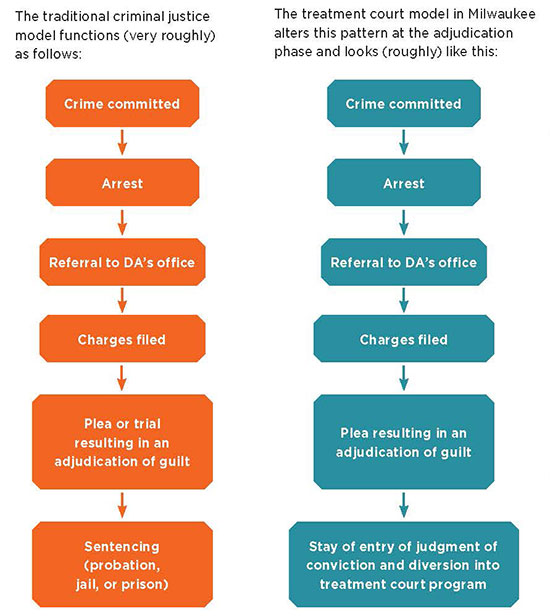
Nearly every week we learn of more sad stories related to addiction. Annual drug-related deaths continue to rise in Wisconsin, just as they do throughout the United States, with heroin leading the way.1 With use and abuse come not only the potential for death but also dysfunction: children put at risk, relationships broken, economic drain, criminal activity, and self-destructive behaviors.2 Wisconsin lawyers may have clients or family members affected by the opioid crisis; some of these individuals may have been charged with crimes. Treatment courts are one of the options available.
In recent decades, Wisconsin – like other states and the federal government – has attempted to address this problem through the criminal justice system. The principle approach was punishment, often including confinement. Milwaukee County followed suit. In 2008, however, the Milwaukee County Adult Drug Treatment Court was launched, followed by a Veterans Treatment Initiative in 2012. These programs have added a valuable tool in the fight against drug addiction and its attendant antisocial consequences. This article explains these programs and notes how they differ from a traditional approach. (Treatment courts are available in dozens of Wisconsin counties.)
Structure of Traditional and Treatment Court Models
The traditional criminal justice model functions (very roughly) as follows: crime committed → arrest → referral to the district attorney’s office → charges filed → plea or trial resulting in an adjudication of guilt → sentencing – generally probation, jail or prison.
The treatment court model in Milwaukee alters this pattern at the adjudication phase and looks (roughly) like this: crime committed → arrest → referral to the district attorney’s office → charges filed → plea resulting in an adjudication of guilt → stay of entry of judgment of conviction and diversion into the treatment court program.
Treatment Court Participants
Only nonviolent, addicted offenders at risk of continuing to reoffend are eligible. Adult drug treatment court research nationwide shows this population is best suited for the highly intensive, strictly monitored treatment court program. Potential participants are screened for addiction and potential mental illness. The Milwaukee County District Attorney’s office reviews each referral to determine that the potential participant’s criminal behavior (in both the current case and before the current case) includes no violent offenses or offenses where a gun was used.
 The Hon. Ellen R. Brostrom, UCLA 1995, a Milwaukee County circuit court judge, presided over the Milwaukee County Adult Drug Treatment Court and Veterans Treatment Initiative from Aug. 1, 2013 to July 31, 2015. She has served on the Wisconsin Association of Treatment Court Professionals board and continues to instruct judges statewide on treatment court processes and best practices. Judge Brostrom was elected to the bench in 2009 and reelected in 2015.
The Hon. Ellen R. Brostrom, UCLA 1995, a Milwaukee County circuit court judge, presided over the Milwaukee County Adult Drug Treatment Court and Veterans Treatment Initiative from Aug. 1, 2013 to July 31, 2015. She has served on the Wisconsin Association of Treatment Court Professionals board and continues to instruct judges statewide on treatment court processes and best practices. Judge Brostrom was elected to the bench in 2009 and reelected in 2015.
In the treatment court, the participant will get up to 18 months of highly structured, supervised programming to empower him or her to successfully enter recovery and move from antisocial to pro-social behaviors. If the person is successful, the original charges are generally dismissed and no conviction or sentencing results. If the participant fails the program, judgment of conviction is entered and the person proceeds to sentencing like the above.
Recovery, like addiction, is a learned behavior. It is an iterative process of trial and error, with the goal being behavior modification. The addict generally has to change friends, recreation, and habits. It is an entire lifestyle modification, altering “people, places, and things” – as we say in treatment court. The treatment court model uses principles of behavior modification to coerce and empower the person to make the needed changes.
Treatment Court Structure
The treatment court program is divided into four phases, which correspond generally to the progression of recovery. Earlier phases expect that relapse will occur. Later phases expect consistent sobriety in order to graduate. Throughout the 12-to-18-month program, the participant is randomly tested for drugs and alcohol two or three times per week, with testing conducted Monday through Saturday. The regimen is tough: urine drops are observed; missing a test is a major infraction.
Samples are tested for dilution or other means of trying to fudge the outcome. Each sample is tested for THC, cocaine, opiates, amphetamines, methamphetamines, and oxycodone. Alcohol is tested by breathalyzer, and for some participants, SCRAM (Secure Continuous Remote Alcohol Monitor). If the circumstances warrant, a wider panel can be ordered, to test for substances including barbiturates, Benzodiazepine, methadone, MDMA, and buprenorphine.
At the same time, the program marshals resources to support recovery in a way most participants could not on their own. Residential treatment is the norm in the early phases of the program. Some individuals may also need treatment for coexisting mental illness. Full-day treatment generally follows, with housing assistance provided.
Individuals who successfully complete the treatment court program are less likely to reoffend, resulting in fewer subsequent criminal justice costs.
It is hoped that in later phases participants will engage in school or work or other productive activities, in addition to continuing with recovery support groups and therapy. The greatest impediment to the overall success of the program is the limitation of resources: treatment, housing, and adequate mental health services exist at levels far below what is needed in Milwaukee County.
The treatment court program uses a team-based model. The team includes the judge, prosecutors, defense attorneys, law enforcement, case managers, treatment providers, housing providers, mental health professionals when indicated, and peer mentors. For the veterans, the peer mentors are key, as veterans seem to know and understand veterans in a special and empowering way.
In Phase I, participants appear in court before the judge weekly. In Phase II, court appearances are every other week. In Phases III and IV, they are once every four weeks. However, if a participant violates a rule, fails to attend treatment, has a missed or dirty test, or commits some other infraction, then he or she is brought into court to appear before the judge that business day or the next, absent extraordinary circumstances. Principles of behavior modification show that immediate and certain consequences are key; severity is secondary or even counterproductive. The point is accountability and swift and certain response.
Each court appearance is preceded by a meeting of the entire team. A report is prepared updating the team on the participant’s most recent compliance (or lack thereof) in all aspects of the program. The team reviews the report, and collectively advocates for potential responses from the court. The judge is the ultimate decision-maker (as is necessary for proper due process), but team members are considered experts who inform the judge’s thinking and decisions.
Crime Model Comparison

Benefits of Treatment Court
It is an incredible thing to see an individual go from dysfunctional and desperate to functional and recovering. Key relationships are often healed along the way. Bodily and mental health are recovered. Babies are born drug free and with proper prenatal care.3 Freedom from the compulsion to use leads to freedom to build a productive, normal life. Participants step out of the shadows where violence and sorrow abound, into the light of the recovery community. Veterans move from moral injury and trauma, to healing and integration.
It is a privilege to walk with participants on the journey. Even those who fail ultimately are likely to find the way to succeed: the skills and tools they learned while trying to successfully complete the program can help them reach full recovery upon exiting jail or prison after revocation.
The benefits of the treatment court model are not just personal. They are financial. Participants who graduate from the program will spare the state or county substantial incarceration costs. Individuals who successfully complete the treatment court program are less likely to reoffend, resulting in fewer subsequent criminal justice costs.4 They are also more likely to successfully access needed financial and social services.5 They are more likely to have repaired critical family relationships, which may include reunification with their minor children, providing them a stable home environment.6
Whether or not they personally know someone affected by the opioid crisis, Wisconsin lawyers can support treatment courts from a policy perspective and can express that support to their county and state elected officials.
Treatment courts are not a panacea for human dysfunction. They are, however, a valuable tool in the criminal justice tool box. The people of Milwaukee County are well served by its Adult Drug Treatment Court and its Veterans Treatment Initiative.7
Meet Our Contributors
How To Get Through Wisconsin’s Winters
 I love the great outdoors, and when winter hits, that means fat-tire mountain biking: Take a traditional mountain bike, widen its forks and outfit it with fat, knobby tires, and take to the trails. It’s a great way to experience winter in Wisconsin.
I love the great outdoors, and when winter hits, that means fat-tire mountain biking: Take a traditional mountain bike, widen its forks and outfit it with fat, knobby tires, and take to the trails. It’s a great way to experience winter in Wisconsin.
I like to bike the Milwaukee River Trail, the John Muir trail in the Southern Kettle Moraine, and Winman Trail in Winchester, Wis. (near Manitowish Waters). I have even been known to put on a head lamp and bike the trails at night. When I can’t be on a bike, I like to hike the snowy woods of Wisconsin – anything to get outdoors!
Hon. Ellen R. Brostrom, Milwaukee County Circuit Court, Milwaukee.
Become a contributor! Are you working on an interesting case? Have a practice tip to share? There are several ways to contribute to Wisconsin Lawyer. To discuss a topic idea, contact Managing Editor Karlé Lester at (800) 444-9404, ext. 6127, or email klester@wisbar.org. Check out our writing and submission guidelines.
Endnotes
1 Wis. Dep’t of Health Servs., Wisconsin Epidemiological Profile on Alcohol and Other Drugs, 2016, at 38-40 (Nov. 2016).
2 U.W. School of Med. & Pub. Health, Impact of Alcohol and Illicit Drug Use in Wisconsin, (last visited Feb. 7, 2019).
3 Douglas B. Marlowe et al., Painting the Current Picture: A National Report on Drug Courts and Other Problem-Solving Courts in the United States 15, Nat’l Drug Ct. Inst. (NDCI) (June 2016).
4 Id.
5 Id.
6 Id. Milwaukee County also has a family drug treatment court. While not the subject of this article because it is not a criminal court, it functions on the same principles. Its goal is family reunification, which it achieves far more successfully than traditional adjudication of children in need of protective services.
7 As of April 2018, Wisconsin had 86 operational treatment-type courts: 37 drug courts, 17 OWI courts, 8 veterans treatment courts, 12 hybrid OWI/drug courts, 4 mental health courts, 4 tribal healing to wellness courts, and 3 family dependency courts.
